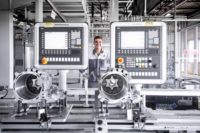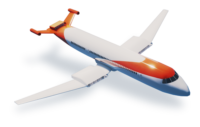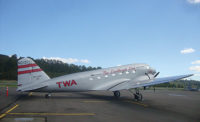Whenever anyone mentions hybrid-electric vehicles today, most people automatically think of cars, buses and trucks. But, up in the sky, the technology is also getting a lot of attention from aerospace engineers. That’s because electric systems are greener, lighter, quieter and more energy-efficient than traditional alternatives.
Electric propulsion technology is one of the biggest trends in the aerospace industry today. The goal is to develop the equivalent of a flying Prius or Tesla. However, that’s easier said than done.
Electric aircraft pose numerous challenges to engineers, such as performance, reliability, safety and weight. It also requires a new class of components, such as batteries, controls, electronics, generators, motors, supercapacitors and wiring harnesses, and a different way of thinking about aircraft design and assembly.
A handful of all-electric, manned aircraft have already completed successful test flights. Many other planes are currently in various stages of development.
All the leading players in the commercial aerospace sector, including Airbus, Boeing, General Electric, Honeywell, Rolls-Royce and United Technologies, are pouring millions of dollars into R&D efforts. It’s also attracting interest from Silicon Valley companies such as Google, Tesla and Uber.
“Hybrid electric flight represents one of the biggest industrial challenges of our time,” claims Andy Anderson, chief operating officer for corporate technology at Airbus Group. “Our goal is to create aircraft designs that generate zero-emissions. We hope to reduce, and possibly eliminate, the use of fossil fuels in aviation within the next 30 to 40 years.”
While some companies are tight lipped, Airbus is publicly promoting its research on electric propulsion systems. In 2015, the company made aviation history when its E-Fan aircraft made the first electric-powered flight across the English Channel.
The experimental plane features twin electric ducted fans that are mounted to the middle of the fuselage. For power, it relies on more than 1,100 lithium-ion battery cells located in the wings.
Engineers at NASA are also busy working on several projects that are exploring the pros and cons of electric architectures. For instance, sometime next year, it plans to fly a small battery-powered plane called the X-57. It will use 14 electric motors to turn propellers integrated into an ultra-thin wing. The goal is to achieve a dramatic reduction in the amount of energy required for a two-seat plane to cruise at 175 mph.
In addition, NASA engineers are examining the types of materials used in electrical systems. For instance, they’re conducting research on the conductors inside, and the insulation around, cables and wires. And, along with studying the design of electric motors and the architecture of power electronics, engineers are improving magnetic materials and semiconductors to make motors and electronics lighter and more efficient.
According to most experts, the real breakthrough will come when such advanced technology can be applied to commercial aircraft. In fact, by the end of the next decade, electric propulsion could be used on jetliners that contain up to 100 seats.
“As large airline companies compete to reduce emissions, fuel burn, noise and maintenance costs, more of their aircraft systems will shift to using electrical power,” predicts Rodger Dyson, Ph.D., technical lead for hybrid gas electric propulsion at NASA Glenn Research Center.
Dyson and his colleagues are experimenting with a hybrid-electric system in which a traditional engine would shut off after a jetliner is airborne. Once it reaches cruising altitude and speed, the aircraft would switch over to battery power and smaller, energy-efficient engines.
They also envision electric drive systems that could be used for ground operations at airports, such as taxiing to and from runways. NASA’s Electric Aircraft Testbed (NEAT) recently began to experiment with various types of electric motors that could realistically power a small, one- or two-person plane.
“Once complete, NEAT will be a world-class, reconfigurable testbed that will be used to assemble and test the power systems for large passenger airplanes with more than 20 megawatts of power,” says Dyson. “We’re going to upgrade the size of these motors to learn how to make them more efficient and lighter weight.”
Sky-High Potential
Electric propulsion offers numerous benefits to aerospace engineers. It can help reduce air pollution, save weight, decrease noise levels and improve overall efficiency.
“The level of effort today is similar to what Toyota allotted to hybrid cars 20 years ago,” says Peter Harrop, Ph.D., chairman of IDTech Ex Ltd., which has conducted several studies on the topic. “However, electric aircraft face much tougher demands and regulatory requirements than land-based vehicles.”
Despite that, Harrop believes the technology has reached a tipping point and that the market for manned electric aircraft will blossom into a $24 billion business by 2031. “The benefits of electric power trains go beyond elimination or reduction of emissions at point of use and smoother ride,” he explains. “In aviation, the fact that you can distribute power and thrust around the airframe, and truly integrate aerodynamics and propulsion, is key.”
“The trend toward electric air vehicles is predominantly driven by environmental considerations, including lower emissions,” adds Carl Schaefer, an engineer at Aurora Flight Sciences Corp. The company is working on a wide variety of electric aircraft programs, all using different generation and distribution architectures.
Schaefer is leading an effort to develop a vertical take-off and landing (VTOL) aircraft for the Defense Advanced Research Projects Agency (DARPA).
The LightningStrike, which is scheduled to make its maiden flight sometime next year, pushes the limits of technology by combining plane-like speed and helicopter-like agility into one aircraft. A modularized, cellular aerodynamic wing design with integrated propulsion will enable the vehicle to perform efficiently in both forward flight and while hovering.
The radical design relies on a synchronous electric drive system and both tilt-wing- and tilt-canard-based propulsion for vertical takeoff and landing. A Rolls-Royce AE 1107C turboshaft engine will power three Honeywell generators and 24 ducted fans distributed on both the wings and canards.
“Electric fixed-wing and VTOL aircraft enable [engineers] to consider unique aircraft designs in which the vehicle configuration is no longer constrained by a requirement to wrap the aircraft around a propulsion system,” explains Schaefer. “Take, for instance, a commercial airliner.
“Generally, the turbofan engines are located either beneath the wing or on the aft fuselage,” adds Schaefer. “This configuration works very well, but the designer has little flexibility to consider more efficient propulsion systems. Practical constraints, such as mechanical shafting, preclude innovative systems, such as distributed propulsion.
“To move to something like distributed propulsion, we need to take a transmission-agnostic approach,” Schaefer points out. “Distributed electric propulsion (DEP) systems eliminate the need for mechanical shafting and bearings in favor of electrical conductors that provide the flexibility to place the propulsion system anywhere we like on the aircraft.”
The LightningStrike’s DEP system consists of highly integrated, distributed ducted fans that, combined with the synchronous electric drive system, will enable the aircraft to hover efficiently and fly forward at high speeds.
“By tightly coupling the propulsion with the aerodynamics, configurations like the ducted fan, canard configuration on the LightningStrike aircraft allow us to shape the lift distribution on the wing for better performance across the flight envelope,” claims Schaefer.
Pure electric aircraft that rely solely on batteries to provide propulsion are severely limited in range and endurance. The energy and power density of current battery technology is not where it needs to be to make this an efficient and practical solution.
For instance, the jet fuel capacity of a Boeing 787 jetliner is approximately 223,000 pounds. The estimated weight of a battery pack with an equivalent amount of power would be more than 4 million pounds.
“The greatest limitation to using battery-powered aircraft is weight,” says Pat Anderson, Ph.D., professor of aerospace engineering and director of the Eagle Flight Research Center at Embry-Riddle Aeronautical University. “Unless there is a cosmic change in [battery technology], it’s just not going to work for bigger, faster airplanes. It’s going to be a really long time before batteries weigh less than liquid fuel.”
That’s why many aerospace engineers are eager to explore the use of hybrid-electric technologies.
“This propulsion architecture allows us to use a turboshaft-driven generator to provide electricity to one or more electric motors,” explains Schaefer. “If one uses AC vs. DC as the basis for the power distribution system, substantial weight savings are possible, since we eliminate the need for power switching electronics, including inverters and motor controllers. Reliability is also improved, especially for highly redundant DEP architectures, where it’s possible to lose one or more electric motors and still return safely to base.”
Technical Challenges
Using electricity to propel planes creates numerous headaches for aerospace engineers. In addition to tackling weight issues, they must improve numerous factors, such as electric power-generation efficiency, power density and size.
“The technology enabling pure electric, battery-powered aircraft is here now, but the limited range and endurance of these systems will limit them to niche general aviation aircraft for some time to come,” warns Schaefer. “The weight and relative inefficiencies of these systems will preclude this architecture from serious consideration for large aircraft for quite some time.”
“A gas-turbine engine is not very efficient in converting fuel into energy to drive a propeller shaft or a jet engine fan,” says Chris Perullo, a research engineer in the Aerospace Systems Design Laboratory at the Georgia Institute of Technology. “They’re less than 50 percent efficient vs. more than 90 percent for electric propulsion systems.
“In addition, electric systems are more reliable, although they require more components in the drive train,” Perullo points out. “From a performance standpoint, electric motor technology makes the most sense for short-haul commuter flights.”
Batteries are another huge hurdle that needs to be addressed. Unfortunately, lithium-ion and other current options have a limited storage capacity and add extra weight to aircraft. Perullo says aerospace engineers must find new ways to increase the energy density of batteries to three or four times what it is today.
“As electrification increases on aircraft, the complexity of managing the systems will become a challenge,” adds Paul Kostek, a systems engineer at Air Direct Solutions LLC and former president of the IEEE Aerospace and Electronic Systems Society. “Ensuring that there is sufficient power available for minimum operations will be a requirement of [future] designs. Power management will be essential for success, and interconnectivity will become a necessary part of the implementation.
“Improved batteries will be the driver,” claims Kostek. “Decreased size and extended life will both be necessary for full electrification. One thing we know, at least for an aircraft, is that lithium-ion
batteries are a no-go. For an electric aircraft to succeed, a new generation of batteries must be introduced. It could be lithium-air, potassium or fuel cells.”
Aerospace engineers must also develop new types of wiring systems that can handle high voltages at high altitudes.
“Aircraft today are limited to about 270 volts,” says NASA’s Dyson. “As you gain altitude, arcing can occur. For instance, at 35,000 feet, where the air is thinner, electricity likes to jump from one conductor to another.
“It looks like the optimal voltage of commercial aerospace applications will be 2,400 volts,” explains Dyson. “But, we need an alternative to traditional copper cabling and insulating material, which weighs too much. Heat dissipation is a big issue. One option that we’re looking at is superconducting technology, but that would require a cooling system.”
“The use of superconductors in cables, motors and generators is an efficient and lightweight breakthrough for electric flight,” adds Christian Wolff, head of the electrochemical systems team at Airbus. “These materials could significantly reduce the size and weight of electrical distribution systems compared to today’s technology.
“Another promising option in superconductivity is the use of high-temperature superconductors, which exhibit the same properties of zero electrical resistance, but at much higher temperatures,” notes Wolff. “This would require less energy for cooling, helping to meet the aviation industry’s lightweight and performance requirements.”
“AC-coupled systems allow the designer to take a unique approach to conductor design that isn’t available to the designer of DC-powered aircraft,” says Schaefer. “The most pressing concern with power distribution wiring and conductors is the elimination of weight.
“Copper is too heavy so for aircraft configurations that rely on multiple electric motors for propulsion,” claims Schaefer. “For nonpropulsive power wiring harnesses, we see some promise in moving toward flexible printed circuit harnesses. Indeed, [we have already] used these harnesses in several unmanned aerial vehicles (UAVs).”
New Applications
Increasing use of air taxis and on-demand aviation services could create a huge market for small electric-powered aircraft that can operate quietly in urban areas. In fact, several ambitious plans call for fleets of nimble VTOLs that can handle cargo or passengers.
Recently, Uber Technologies unveiled plans to change the way that people commute in large cities. While the ride share company’s idea is straight out of the “Jetsons” TV cartoon, it’s not science fiction.
Uber claims the technology currently exists for its Uber Elevate network of on-demand electric aircraft to become a reality. The concept is based on developing a new class of small VTOL aircraft that feature battery-powered electric motors.
The unique vehicles would be able to carry up to four passengers and travel at speeds up to 150 mph for up to
100 miles. Initial plans call for pilots, but the long-term vision is to have the aircraft operate autonomously.
“VTOLs will be an affordable form of daily transportation for the masses, even less expensive than owning a car,” predicts Nikhil Goel, product manager for Uber Elevate and co-author of a white paper on the topic. “Ultimately, if VTOLs can serve the on-demand urban transit case well, there is a path to high production volume manufacturing. The economics of manufacturing VTOLs will become more akin to automobiles than aircraft.”
Uber doesn’t plan to build any aircraft itself, but several third-party projects are almost ready to get off the ground. The designs utilize small electric-powered rotors that produce sufficient power for vertical takeoff and maintain low noise levels.
One of the most serious contenders is the Vahana from Airbus. It features fore and aft tilting wings that contain electric-powered propellers. The aircraft is designed to carry a 1,760-pound payload.
A full-size prototype is expected to fly by the end of this year. The aircraft is being built with a variety of off-the-shelf components. And, Airbus has set up a subsidiary in Silicon Valley called A3 to develop the Vahana.
“The aircraft we’re building doesn’t need a runway, is self-piloted, and can automatically detect and avoid obstacles and other aircraft,” claims Rodin Lyasoff, CEO of A3. “We believe that full automation will allow us to achieve higher safety by minimizing human error. Full automation also enables us to make our aircraft as small and light as possible, and will significantly reduce manufacturing costs.
“Vahana sits at the convergence of trends in urban demographics and rapid improvements in batteries, advanced sensors and mass-produced lightweight composite structures,” adds Lyasoff. “Today, many of the technical and regulatory challenges to scalable, affordable flight are trending favorably.
“Battery safety and energy density are now adequate for airborne applications,” Lyasoff points out. “Low-cost, reliable avionics are becoming broadly available, leveraging decades of UAV development.
“Recent advances in automated composite manufacturing and assembly show that small, lightweight vehicles can be produced at high volumes and significantly lower costs than traditional aerospace methods have previously allowed,” notes Lyasoff. “These trends, along with the rising transportation challenges in metropolitan areas, make the case for a new generation of personal aerial vehicles.”
Engineers are also developing new ways for commercial jetliners to easily adopt electric propulsion systems. NASA wants to help the aircraft industry shift from relying solely on gas turbines to using hybrid-electric and turboelectric propulsion to reduce energy consumption, emissions and noise.
“Aircraft are highly complex machines,” says Jim Heidmann, manager of NASA’s Advanced Air
Transport Technology project. “Moving toward alternative systems requires creating new aircraft designs, as well as propulsion systems that integrate battery technologies and electromagnetic machines, like motors and generators, with more efficient engines.”
The Glenn Research Center is looking at power systems that generate electricity in place of, or in addition to, thrust at the turbine engine, and then convert that electricity into thrust using fans at other places on an aircraft.
“These systems use electric motors and generators that work together with turbine engines to distribute power throughout the aircraft to reduce drag for a given amount of fuel burned,” says Heidmann. “Part of our research is developing the lightweight machinery and electrical systems that will be required to make these systems possible.”
NASA engineers are studying how to make the Boeing 737, the most popular plane used in commercial aviation, more efficient. Their answer is the Starc-ABL (single-aisle turbo-electric aircraft with aft boundary layer ingestion).
“It has a third ducted fan located in the tail of the fuselage that is driven by an electric motor, not a turbine,” explains Dyson. “This will provide a third source of thrust. But, 10 percent to 40 percent of the energy driving the two conventional jet engines will produce electricity to drive the electric motor. This type of rear tail cone thruster could be commercially viable within the next 10 years, with a minimal amount of change to existing fuselages.”










